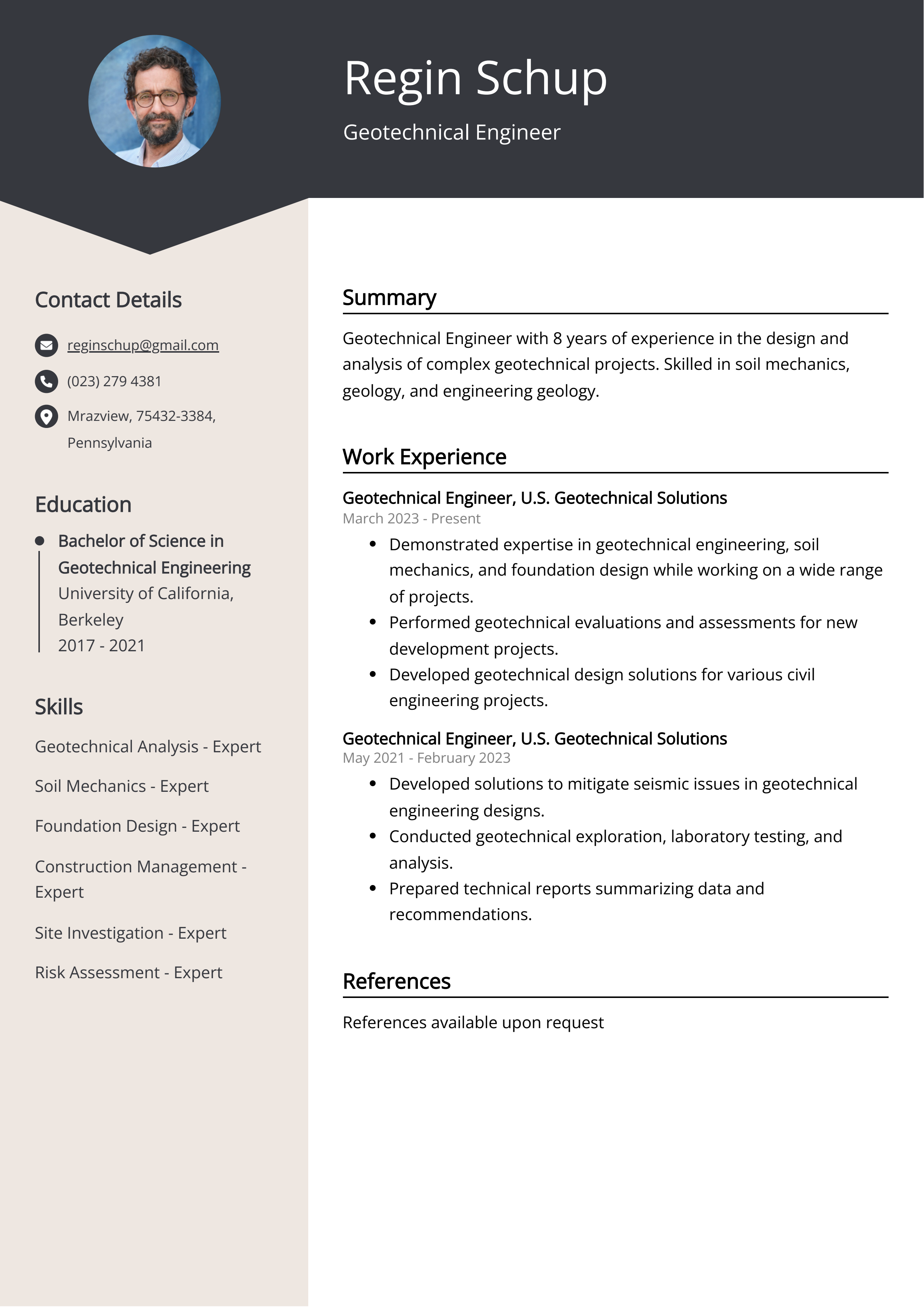More About Geotheta
More About Geotheta
Blog Article
Not known Incorrect Statements About Geotheta
Table of ContentsGeotheta Things To Know Before You BuyIndicators on Geotheta You Need To KnowThe 8-Second Trick For GeothetaRumored Buzz on GeothetaFacts About Geotheta Uncovered

They conduct site investigations, gather examples, carry out laboratory tests, and evaluate data to review the suitability of the ground for building tasks - Tailings Engineer. Based upon their searchings for, geotechnical engineers offer suggestions for structure style, slope stability, retaining frameworks, and mitigation of geotechnical dangers. They collaborate with various other specialists, such as engineers, architectural engineers, and construction teams, to make sure that geotechnical considerations are integrated right into the overall project design and execution
By analyzing the habits and residential properties of dirt and rock, they can recognize possible geotechnical risks such as landslides, dirt negotiation, or incline instability. Their competence assists avoid failures or crashes that might threaten lives and property. Here are some detailed obligations and obligations of a geotechnical designer: Website Investigation: Geotechnical designers conduct website examinations to gather data on subsurface problems.
They interpret the information to comprehend the residential or commercial properties and behavior of the dirt and rock, including their stamina, leaks in the structure, compaction attributes, and groundwater problems. Geotechnical Analysis and Layout: Geotechnical engineers evaluate the information gathered throughout site investigations to assess the security and suitability of the website for building jobs. They perform geotechnical calculations and modeling to evaluate elements such as bearing ability, negotiation, slope security, side planet stress, and groundwater flow.
Our Geotheta Diaries
Foundation Style: Geotechnical designers play an essential function in making foundations that can securely support the designated structure. They analyze the soil conditions and tons demands to figure out the appropriate structure kind, such as superficial structures (e.g., grounds), deep structures (e.g (https://geotheta.edublogs.org/2024/08/02/unlocking-the-world-of-geotechnical-engineers-with-geotheta/)., piles), or specialized techniques like soil enhancement. They consider variables such as settlement limits, bearing ability, and soil-structure interaction to create optimum structure styles
They examine building and construction strategies, display site activities, and carry out area assessments to validate that the design recommendations are followed. If unanticipated geotechnical concerns emerge, they evaluate the scenario and supply suggestions for removal or adjustments to the style. Threat Evaluation and Mitigation: Geotechnical engineers analyze geotechnical hazards and risks associated with the task site, such as landslides, liquefaction, or dirt disintegration.

Collaboration and Interaction: Geotechnical designers work carefully with other specialists associated with a task, such as architects, structural designers, and construction groups. Efficient interaction and partnership are important to incorporate geotechnical factors to consider right into the general project layout and building and construction process. Geotechnical designers provide technical proficiency, answer inquiries, and make sure that geotechnical demands are fulfilled.
Geotheta Can Be Fun For Anyone
Below are some kinds of geotechnical engineers: Foundation Engineer: Structure engineers focus on developing and assessing foundations for structures. They analyze the soil conditions, load demands, and website qualities to identify the most ideal structure kind and style, such as superficial foundations, deep structures, or specialized strategies like stack structures.
They evaluate the elements affecting slope security, such as soil buildings, groundwater conditions, and slope geometry, and develop methods to avoid slope failures and alleviate threats. Quake Designer: Quake designers concentrate on analyzing and designing frameworks to endure seismic forces. They assess the seismic danger of a site, evaluate soil liquefaction capacity, and create seismic layout criteria to make sure the security and durability of structures during quakes.
They carry out area testing, accumulate samples, and evaluate the accumulated data to define the dirt homes, geologic developments, and groundwater problems at a site. Geotechnical Instrumentation Engineer: Geotechnical instrumentation engineers concentrate on tracking and determining the habits of dirt, rock, and frameworks. They set up and preserve instrumentation systems that keep an eye on elements such as dirt settlement, groundwater degrees, slope motions, and structural displacements to assess performance and give early cautions of prospective concerns.
Geotheta for Dummies
They perform tests such as triaxial examinations, consolidation tests, straight shear tests, and leaks in the structure tests to collect information for geotechnical evaluation and style. Geosynthetics Engineer: Geosynthetics designers focus on the layout important link and application of geosynthetic products, such as geotextiles, geogrids, and geomembranes. They utilize these materials to improve soil stability, enhance inclines, provide drainage options, and control disintegration.
They tend to be investigatory individuals, which implies they're intellectual, reflective, and inquisitive. They are curious, methodical, reasonable, logical, and logical. Several of them are additionally social, implying they're kind, charitable, cooperative, individual, caring, valuable, understanding, skillful, and pleasant. Does this audio like you? Take our complimentary career examination to find out if geotechnical designer is among your leading occupation matches.
In the workplace setting, geotechnical engineers use specialized software program tools to execute calculations, produce layouts, and analyze data. They prepare records, evaluation project specs, connect with clients and employee, and coordinate task activities. The workplace setting gives a favorable atmosphere for study, evaluation, and cooperation with various other experts included in the project.
The Single Strategy To Use For Geotheta
They frequently go to project sites to perform site examinations, evaluate geotechnical conditions, and collect information for analysis. These sees entail taking a trip to various locations, often in remote or tough surfaces. Geotechnical designers may carry out soil tasting, conduct examinations, and display construction activities to make certain that the geotechnical aspects of the job are being applied correctly.
Geotechnical engineers likewise function in specialized geotechnical laboratories. In these centers, they perform experiments, perform examinations on soil and rock examples, and examine the engineering properties of the products. Geotechnical laboratory engineers work extensively in these environments, taking care of screening tools, operating tools, and taping data. They work together with various other research laboratory personnel to guarantee accurate and trustworthy screening results.
Report this page